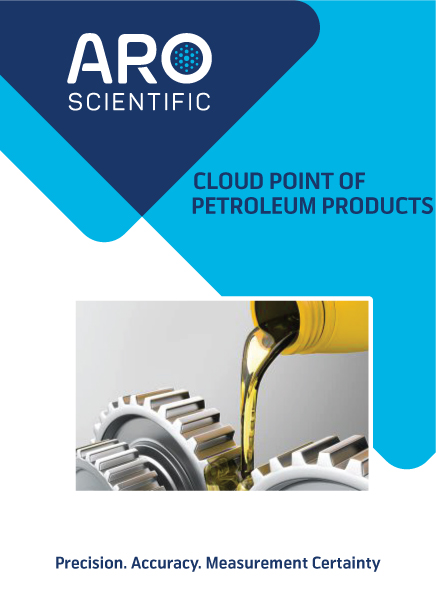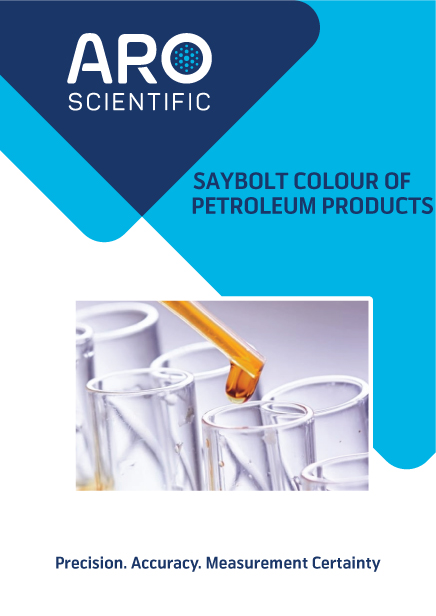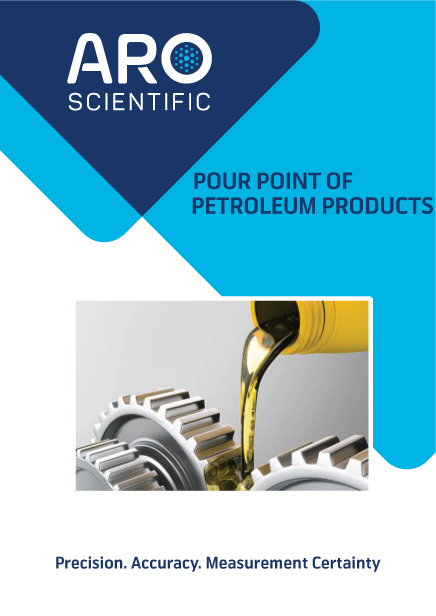Cloud Point of Petroleum Products – A Brief Guide

Introduction
Cloud point is an important property of petroleum products that can greatly impact their performance and reliability. Understanding cloud point is crucial for industries that rely on petroleum products and biodiesel fuels. This brief guide provides an explanation of cloud point, its significance, and how it can be measured accurately using certified reference materials. Whether you are a researcher, technician, or industry professional, This guide aims to provide an overview of the cloud point, including its definition, measurement techniques, factors affecting it, and the importance of using certified reference materials for accurate analysis.
What is Cloud Point or fuel Cloud Point and why is it important in the petroleum industry?
Cloud point refers to the temperature at which paraffin wax or other solid components start to precipitate from a petroleum product, causing it to become cloudy or hazy. This phenomenon can occur in various petroleum products.
Understanding cloud point is of utmost importance in the petroleum industry because it directly impacts the product's flow characteristics and its ability to operate in low-temperature environments. For instance, in the automotive industry, fuel that has a cloud point above the winter season's lowest temperatures may cause engine fuel lines and filters to become clogged, leading to poor engine performance or even engine damage.
Similarly, in the aviation industry, jet fuels with high cloud points can cause complications during flight, such as difficulties in fuel flow, increased fuel filter clogging rates, and, in extreme cases, complete fuel system blockages. Additionally, heating fuel with a high cloud point may not flow properly through pipelines and could potentially result in disruptions to the heating system.
By understanding cloud point and accurately measuring it, industries can ensure that they select and use petroleum products that are suited for their specific applications and environmental conditions. In turn, this helps to optimize performance, improve reliability, and ensure the smooth operation of various systems and equipment.
Factors affecting the Cloud Point of petroleum products
The cloud point of petroleum products is influenced by various factors that can vary depending on the type of product and its composition. Understanding these factors is essential in predicting and controlling the cloud point, ensuring optimal performance in different applications and environments.
One significant factor that affects the cloud point is the presence of paraffin wax or other solid components in the petroleum product. The amount and composition of these solids can vary depending on the crude oil source, refining processes, and additives used. Higher concentrations of paraffin wax or solid components generally result in a higher cloud point, making the product more prone to precipitation at lower temperatures.
Temperature is another crucial factor. As the temperature decreases, the likelihood of solid components precipitating from the petroleum product increases. Therefore, it is essential to consider the lowest temperature conditions the product will encounter during its application and select a product with a cloud point below that temperature to prevent operational issues.
Additionally, the presence of contaminants, such as particulates or water, can significantly impact the cloud point. Contaminants can promote the formation of solid particles and accelerating the clouding process. Proper filtration and dehydration processes can be used to minimize the influence of contaminants on cloud point.
Furthermore, the type and concentration of additives used in the petroleum product can affect the cloud point. Certain additives, such as pour point depressants, can modify the crystal structure of solid components, reducing their tendency to precipitate and lowering the cloud point. On the other hand, the presence of other additives, such as certain antioxidants or viscosity index improvers, may increase the cloud point, potentially compromising performance in low-temperature conditions.
Understanding and controlling these factors is crucial for industries that rely on petroleum products, as it enables them to select the appropriate product or implement necessary measures to manage cloud point issues effectively. In the next section, we will explore the various methods used to measure cloud point accurately, providing insights into the importance of certified reference materials in ensuring reliable measurements.
Testing methods for determining Cloud Point
To accurately determine the cloud point of petroleum products, various testing methods are utilized. These methods provide valuable insights into the behaviour of the product at different temperatures and help in evaluating its suitability for specific applications. Several techniques can be employed to determine the cloud point. Some commonly used methods include, but not limited to:
ASTM D2500 - Standard Test Method for Cloud Point of Petroleum Products and Liquid Fuels
IP 219 - Standard Test Method for Cloud Point of Petroleum Products and Liquid Fuels
When selecting a test method, it's essential to consider factors such as the type of petroleum product, the expected cloud point range, and the laboratory's equipment capabilities. Additionally, adherence to specific standards, whether ASTM, IP, or ISO, is often necessary for regulatory compliance and consistency in testing.
By employing these test methods, industry professionals can accurately determine the cloud point of petroleum products, enabling them to select the most suitable products for specific environmental conditions.
Common challenges and solutions in managing Cloud Point
While understanding the cloud point of petroleum products is crucial, managing and maintaining optimal cloud point temperatures can pose certain challenges. These challenges can vary depending on the industry and application of the product. However, there are solutions available to overcome these challenges and ensure the efficient use of petroleum products.
One common challenge is the impact of temperature fluctuations on the cloud point. In certain industries, such as fuel production and distribution, products are exposed to varying temperatures during storage and transportation. These fluctuations can cause the cloud point to shift, potentially leading to operational issues. To address this, industries often implement temperature control measures, such as insulation and heating/cooling systems, to maintain consistent temperatures and prevent fluctuations.
Another challenge is the presence of impurities in petroleum products. Impurities, such as waxes and contaminants, can affect the cloud point and lead to clogging or reduced performance in applications. To mitigate this, industries adopt purification processes, such as filtration and solvent treatment, to remove impurities and maintain the desired cloud point.
Additionally, the compatibility of petroleum products with other materials can pose challenges. In applications where the product comes into contact with seals, gaskets, or other equipment, the cloud point can influence the effectiveness and lifespan of these components. Industries often conduct compatibility tests to identify suitable materials for specific cloud point ranges and ensure optimal performance.
By addressing these challenges and implementing appropriate solutions, industries can effectively manage the cloud point of petroleum products, ensuring their suitability and performance in various applications.
Impact of Cloud Point on product performance and storage
Understanding the cloud point of petroleum products is not only crucial for managing and maintaining optimal temperatures, but it also plays a significant role in the performance and storage of these products. The cloud point directly affects the functionality, efficiency, and overall quality of petroleum products in various industries.
One industry that is greatly impacted by the cloud point is the automotive industry. In cold weather conditions, a high cloud point can cause diesel fuel to solidify, leading to clogged fuel filters, reduced engine performance, and even engine failure. This is why winter-grade diesel fuel with a lower cloud point is necessary in regions with low temperatures.
The storage and transportation of petroleum products also rely on cloud point knowledge. For example, in the oil and gas industry, proper storage conditions are crucial to prevent solidification of waxes and paraffins. Storage tanks and pipelines need to be insulated and equipped with heating systems to maintain the products' cloud point and prevent blockages.
Understanding the impact of cloud point on product performance and storage allows industries to make informed decisions regarding product formulation, storage requirements, and transportation logistics. In the upcoming section, we will delve deeper into specific examples from various industries, highlighting the challenges faced and the solutions implemented to mitigate cloud point-related issues.
Importance of understanding and controlling Cloud Point for successful petroleum operations.
Understanding and controlling the cloud point of petroleum products is of utmost importance for successful operations in various industries. The cloud point greatly affects the performance and functionality of petroleum products, and optimizing it ensures their efficiency and longevity.
By implementing strategies such as utilizing cloud point depressants, blending different grades of products, and employing proper filtration techniques, industries can effectively manage the cloud point and mitigate related issues. Additionally, controlling storage conditions through insulation and heating systems prevents the formation of waxes and paraffins, avoiding blockages in storage tanks and pipelines.
What is a cloud point reference standard or cloud point reference material
A cloud point reference standard is a substance with a known cloud point value that is used for calibration and validation purposes during cloud point testing of petroleum products. The reference standard or material is employed to verify the accuracy and reliability of the cloud point test apparatus and method.
The cloud point reference standard or material serves as a benchmark against which the performance of the testing equipment and the consistency of testing procedures can be assessed. Typically, the reference standard or material is a substance with a well-established and stable cloud point value, allowing laboratories to check the reliability of their measurements and ensure that the test instrument is providing accurate results.
This reference standard or material is employed to calibrate, verify, and validate the accuracy and precision of cloud point testing equipment and methods. Cloud point reference materials are crucial in quality control and assurance processes for laboratories and industries dealing with petroleum products. By using a known reference material with a certified cloud point value, laboratories can assess the performance of their testing apparatus and ensure that the measurements obtained during the testing process are accurate and reliable.
Using cloud point reference standards and materials that are accredited to ISO 17034 helps laboratories achieve reliable and consistent results in cloud point testing, which is crucial for industries where low-temperature flow properties of petroleum products are significant factors, such as transportation and storage applications in cold climates. There are various International Standards and Guides for the preparation and use of reference materials to maintain the quality and accuracy of cloud point testing procedures.





